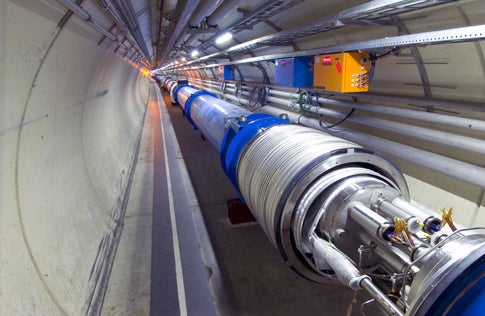Scientists at the Large Hadron Collider (LHC) at CERN, Geneva, are celebrating after achieving another world first today — proton collisions at 7 trillion electron volts (TeV). This significant milestone, the highest energies ever achieved by a man-made particle accelerator (3.5 TeV per proton beam), marks the start of a 2-year campaign that could see scientists make new discoveries about the universe and answer some of the unresolved questions in physics.
“Achieving collisions at 7 TeV marks the start of a new era in physics research,” said John Womersley, particle physicist and director of science programs at the Science and Technology Facilities Council (STFC), which funds the United Kingdom’s particle physics program. “The LHC aims to explore the nature of the universe just moments after the Big Bang, and it will increase our understanding of how it was created, what it is made of, and how it will evolve. During the coming months, scientists will use data collected at these high energies first to cross-check data and theories from previous experiments, and then to search for particles and forces that we know must exist in the universe but have never been observed. In the next couple of years, this could lead to the discovery of a new law of physics called supersymmetry — which could explain the dark matter that seems to dominate our universe — and even to the discovery of the elusive Higgs boson particle.”
“It’s a great day to be a particle physicist,” said Rolf Heuer, CERN director general. “A lot of people have waited a long time for this moment, but their patience and dedication are starting to pay dividends. The LHC has a real chance over the next 2 years of discovering supersymmetric particles and possibly giving insights into the composition of about a quarter of the universe.”
CERN will run the LHC at 7 TeV for 18 months to 2 years to deliver enough data to the A Toroidal LHC Apparatus (ATLAS), Compact Muon Solenoid (CMS), A Large Ion Collider Experiment (ALICE), and LHC beauty (LHCb)) experiments to make significant advances across a wide range of physics areas. As soon as scientists have rediscovered the known standard model particles, a necessary precursor to looking for new physics, the LHC experiments will then start the systematic search for the Higgs boson.
With the amount of data expected, called one inverse femtobarn by physicists, the combined analysis of ATLAS and CMS will be able to explore a wide mass range, and there’s even a chance of discovering the Higgs boson if it has a mass near 160 GeV (gigaelectron volts). If it’s much lighter or very heavy, it will be more difficult to find in the LHC’s first run.
For supersymmetry, ATLAS and CMS will each have enough data to double today’s existing sensitivity to certain new discoveries. Experiments today are sensitive to some supersymmetric particles with masses up to 400 GeV. Such a high data volume at the LHC pushes the discovery range up to 800 GeV.
Even at the more exotic end of the LHC’s potential discovery spectrum, this LHC run will extend the current reach by a factor of two. LHC experiments will be sensitive to new massive particles, indicating the presence of extra dimensions up to masses of 2 TeV — today’s reach is around 1 TeV.
“There is a whole new landscape of physics to explore at these energies,” said Jon Butterworth from the University College London. “Somewhere in that landscape nature has hidden the way forces are unified and how particles get mass. Today the LHC gets us over the horizon, and we start our exploration!”
“For the last two decades, we have been preparing to make this leap into exploring a new realm of nature,” said Jordan Nash from Imperial College London. “Our studies of the universe and the particles we have been able to produce in accelerators up until now show us that there are important pieces missing in our understanding of the basic building blocks of the universe. Operating the LHC at these energies much higher than ever achieved before will allow us to search for these and find out more about what our universe consists of. Our first taste of data at low- energy operation of the LHC has shown us that our detectors are ready to capture and analyze the data with exquisite precision, and we are all standing by ready to see what nature has in store for us.”
Once the LHC has completed this long run of 18-24 months, there will be a long shutdown of roughly a year during which the LHC will be upgraded and prepared for running at its design energy of 14 TeV. Traditionally, CERN has operated its accelerators on an annual cycle, running for 7 to 8 months with a 4-to-5-month shutdown each year. Being a cryogenic machine operating at very low temperature, the LHC takes about a month to bring up to room temperature and another month to cool down. A 4-month shutdown as part of an annual cycle no longer makes sense for such a machine, so CERN has decided to move to a longer cycle with longer periods of operation accompanied by longer shutdown periods when needed.
“Two years of continuous running is a tall order both for the LHC operators and the experiments, but it will be well worth the effort,” said Rolf Heuer. “By starting with a long run and concentrating preparations for 14 TeV collisions into a single shutdown, we’re increasing the overall running time over the next 3 years, making up for lost time and giving the experiments the chance to make their mark.”










